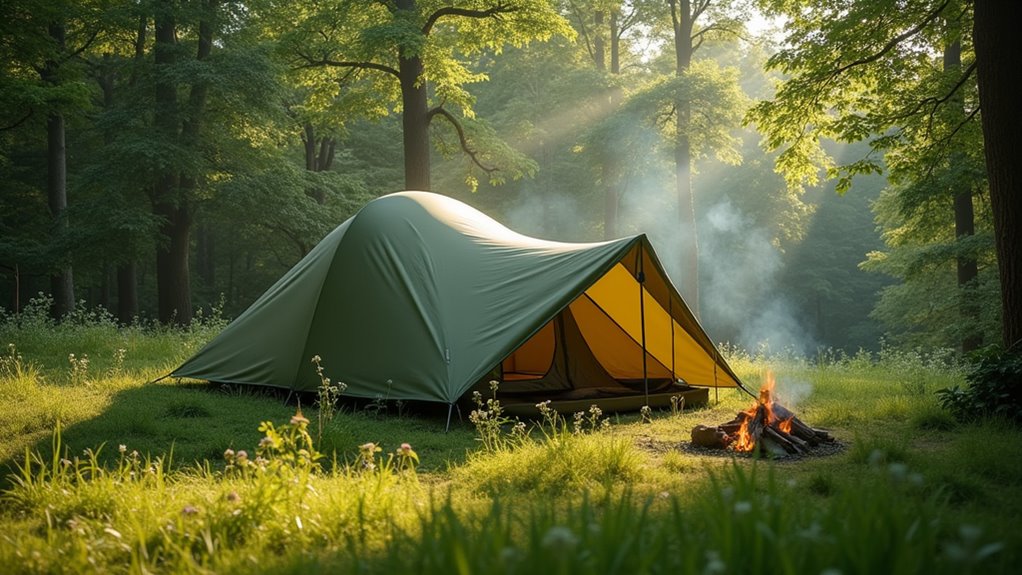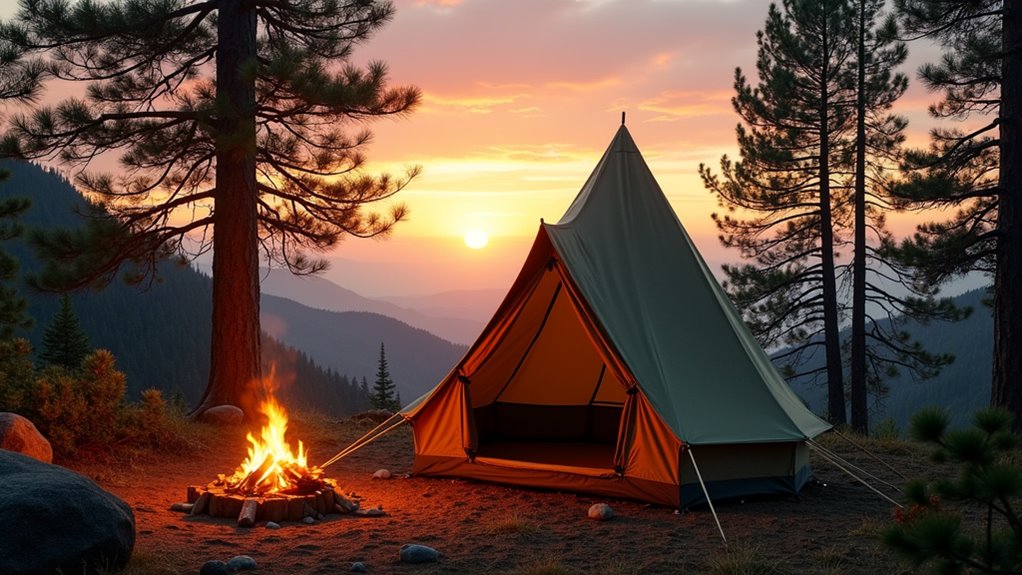What Is The Shape Of Tent
This post contains affiliate links. As an Amazon Associate, we earn from qualifying purchases.
Tents come in a variety of shapes designed to meet different camping needs, including dome, tunnel, A-frame, cabin, and geodesic styles. Each shape offers distinct advantages, from stability and spaciousness to weather resistance. Further explanation and details about these tent shapes will be provided later in the article for those interested in learning more.
Essential Facts in 30 Seconds
- Tents come in various shapes: dome, tunnel, A-frame, cabin, and geodesic.
- Dome tents have a half-sphere shape, offering stability and wind resistance.
- Tunnel tents feature a curved design, providing spacious interiors and easy setup.
- A-frame tents have a triangular shape, durable in harsh weather.
- Cabin tents have vertical walls and large interiors for comfort and airflow.
Dome Tent Shape
Dome tents have a unique half-sphere shape. Their flexible poles cross each other, making a strong frame. This frame stands on its own without extra support. This design helps the tent resist strong winds and go up fast.
Most dome tents use tough materials like nylon or polyester. These materials protect well against rain, snow, and wind. Additionally, the use of tough materials enhances durability and longevity.
The round shape helps water and snow slide off easily. This stops water from collecting on top. The tent can stand on rough ground like rocks or sand. For even stronger tents, try geodesic dome tents. They’ve many poles crossing for extra strength.
Dome tents offer plenty of space inside. You can sit and move around comfortably. They work well for one person or a small group. Additionally, they are often favored by backpackers and climbers for their portability and ease of setup.
Tunnel Tent Shape

Tunnel tents provide roomy and flexible shelter for campers. They’ve several curved poles that form a tunnel shape. This design offers plenty of headroom and floor space.
Usually, tunnel tents use two or three curved poles to create steep side walls. These walls feel like cabin tents but are lighter. Additionally, robust frame features contribute to the tent’s ability to withstand harsh weather conditions.
Tunnel tents suit families or groups because of their space. Many models have waterproof outer layers and inner sleeping areas. Bigger tents often include vestibules for storing gear.
The tent’s strength comes from tight fabric. Using good flysheet material helps resist strong winds. Additionally, waterproof ratings are crucial for ensuring that the tent remains dry in rainy conditions.
These tents set up quickly and weigh less than many others. Place them carefully and use guylines to keep steady in bad weather.
Tunnel tents balance size, weight, and stability well. They work great for camping trips where space and comfort matter.
A-Frame Tent Shape

The A-frame tent shape is easy to spot with its sharp triangle design. Two slanting walls join at the top, making a strong ridgepole. This shape holds firm against wind, rain, and snow. It works well in many weather conditions. Additionally, tent cards can be used inside the tent to promote activities or provide important information to campers.
Materials like aluminum alloy and coated polyester keep the tent light and easy to carry. Setting it up takes just a few minutes.
Military and scouts used A-frame tents for their simple, useful design. Now, new materials and styles bring this classic tent back. Sizes vary, from small tents for solo campers to big ones for groups.
The clearspan design inside gives plenty of space to move. Some tents come with zippered doors and windows. These let fresh air in and keep bugs out.
This tent suits anyone who loves camping and wants comfort outdoors. Additionally, the use of polyester tent materials enhances durability and provides resistance to UV damage, making it a practical choice for family camping.
Cabin Tent Shape
Cabin tents offer roomy and practical designs, perfect for families and groups. Their nearly vertical walls create large interiors with plenty of floor space. You can stand up straight and move easily inside. High ceilings and flat roofs add to the open, airy feel.
These tents include big windows for good airflow and natural light. Mesh panels keep bugs out while letting fresh air in. Full rainflies and sealed seams protect against heavy rain, keeping you dry. Adjustable vents help stop moisture buildup and keep air flowing. The durable construction of cabin tents ensures they can withstand harsh weather conditions.
Many cabin tents have several doors and storage areas called vestibules. They work well for longer trips and hold lots of gear. Cabin tents are reminiscent of yurt tents, which also blend comfort with a spacious design.
Cabin tents make camping feel like home, comfortable and spacious for everyone.
Geodesic and Semi-Geodesic Tent Shapes
Geodesic and semi-geodesic tents offer strong, practical shelter options.
Geodesic tents have a dome shape made of many triangles. This shape spreads stress evenly. It makes the tent very strong and stable. These tents stand up well to strong winds and heavy rain. Campers and emergency workers find them very useful.
Semi-geodesic tents use fewer poles and simpler shapes. They still stay strong but are easier to set up. These tents work well in mild weather.
Both types of tents have open interiors. There are no poles inside to get in the way. This gives more space for sleeping or storing gear. People like these tents for their strength and roominess. Additionally, the durability of these tents can be enhanced by using high denier nylon, which reduces the risk of tearing during harsh weather conditions.
Frequently Asked Questions
What Materials Are Commonly Used for Tent Fabrics?
Tent fabrics often use polyester and nylon. Polyester costs less and resists water well. Nylon stands out for its strength and lasts longer. Both fabrics suit many camping trips. People pick them for tents because they work great outdoors. Polyester lets water roll off quickly. Nylon can handle rough weather and tough use. These materials keep campers dry and safe. They make setting up tents easier too. Many campers trust these fabrics for their trips.
How Do I Properly Maintain My Tent?
Keep your tent clean by washing it with mild soap and water. Let it dry completely before storing. Store the tent in a cool, dry place away from sunlight. Avoid folding or compressing the tent too tightly. This helps keep the fabric strong and waterproof. Proper care can extend your tent’s life by years. A well-maintained tent stays safe and comfy on every trip.
What Tent Shape Is Best for Winter Camping?
Dome and pyramid tents work best for winter camping. They stay strong in snow and wind. Tents with thick insulation keep you warm and dry. Use tents made from tough materials to handle cold weather. These shapes spread weight evenly, preventing collapse. Good ventilation stops frost inside the tent. Pick tents with sturdy poles for extra support. Stay safe and comfortable in harsh winter conditions.
Can I Pitch a Tent on Sand or Gravel?
Pitching a tent on sand or gravel works well with the right gear. Sand anchors or heavy rocks keep your tent steady. Normal tent stakes often slip in loose ground. Secure your tent tightly to resist wind. Many campers enjoy stable setups on beaches or rocky areas. A solid tent means a cozy night under the stars.
How Do I Choose the Right Tent Size for My Group?
Pick a tent that fits your group size and gear. Always buy a tent for two extra people. This gives space to move and store items. For example, a tent for four people works best for two campers. Check the tent’s capacity label before buying. Some tents feel smaller inside, so size up for comfort. Think about weather and how long you will stay. Bigger tents help if you stay inside during rain. Choose a tent that feels roomy and safe for your group.
Conclusion
Tents come in many shapes like dome, tunnel, A-frame, cabin, and geodesic. Each shape has its own strength and use. Dome tents are good for wind and rain. Tunnel tents give lots of space inside. A-frame tents are simple and light. Cabin tents stand tall and feel roomy. Geodesic tents are strong and stable in tough weather. Picking the right shape helps you stay safe and comfortable outdoors. It makes camping easier and more fun. Choose the tent shape that fits your trip and weather. That choice can change your whole camping night.
